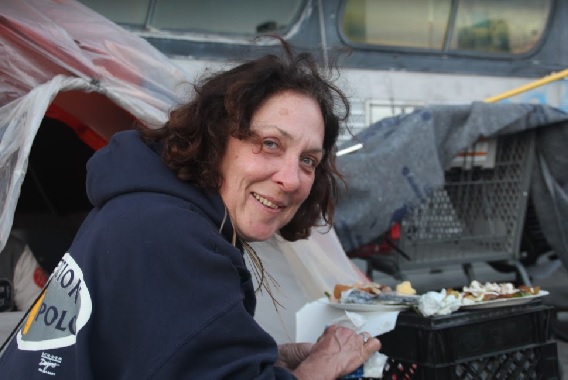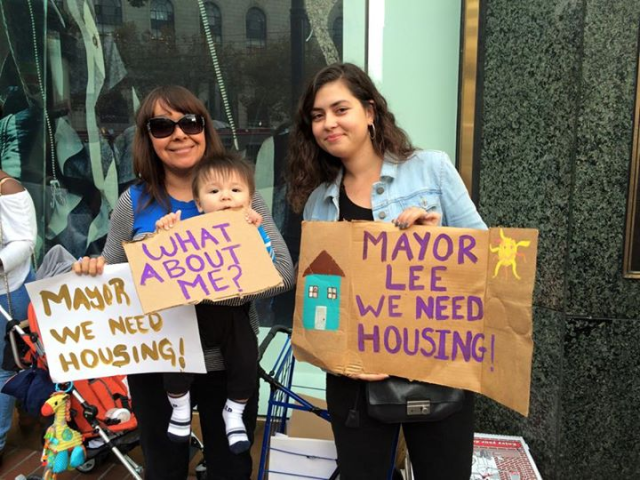Editors note: The SF Chronicle is leading an effort to get local news media to report on homelessness this week. We are happy to be involved — and to offer what we suspect is a very different perspective. Over the next couple of days, we will run stories from people who know what it’s like to be poor and homeless — and an analysis of how the city’s major daily paper and its columnists and editorials have covered the issue. For starters, here’s some perspective. View our full coverage here.
I’m going to make a big political leap here and say that the reason there are so many homeless people on the streets of San Francisco has something to to with the reason that there are so many angry people in this country (and in Britain) who are now voting against the establishment.
There’s a strong current of racism, homophobia, and xenophobia involved (including Trump, the Brexit, and our approach to homelessness). Consider the numbers of African American and LGBT, especially transgender, people living on the streets in part because they are unable to get jobs that pay enough to cover the rent. And keep in mind that some of the complaints against homeless people originate with cisgender white people who see our neighbors living on the street as a “quality of life (for the rich) issue” (see: Ed Lee, Scott Wiener).

But there’s something else going on, too (see: Bernie catching everyone by surprise – and the apparently “stubborn” homeless numbers in SF). The economic program that’s been in place in the United States and Britain for the past several decades, which seeks to limit the role of government, provide unlimited support for the private sector, and allow wealth to accumulate at the top, has utterly failed.
You can call it “neoliberalism” or call it something else, but here, as UK Guardian columnist George Monbiot notes, are its main characteristics:
Neoliberalism sees competition as the defining characteristic of human relations. It redefines citizens as consumers, whose democratic choices are best exercised by buying and selling, a process that rewards merit and punishes inefficiency. It maintains that “the market” delivers benefits that could never be achieved by planning.
Attempts to limit competition are treated as inimical to liberty. Tax and regulation should be minimised, public services should be privatised. The organisation of labour and collective bargaining by trade unions are portrayed as market distortions that impede the formation of a natural hierarchy of winners and losers. Inequality is recast as virtuous: a reward for utility and a generator of wealth, which trickles down to enrich everyone. Efforts to create a more equal society are both counterproductive and morally corrosive. The market ensures that everyone gets what they deserve.
We internalise and reproduce its creeds. The rich persuade themselves that they acquired their wealth through merit, ignoring the advantages – such as education, inheritance and class – that may have helped to secure it. The poor begin to blame themselves for their failures, even when they can do little to change their circumstances.
Never mind structural unemployment: if you don’t have a job it’s because you are unenterprising. Never mind the impossible costs of housing: if your credit card is maxed out, you’re feckless and improvident. Never mind that your children no longer have a school playing field: if they get fat, it’s your fault. In a world governed by competition, those who fall behind become defined and self-defined as losers.
And that’s how we see housing and homeless policy in San Francisco.
For years, under Democratic mayors and boards of supervisors whose members call themselves Democrats, in a city that has a reputation for progressive politics, we have followed the neo-liberal line, to wit:
The private sector is the primary source of housing; in fact, anything that slows the private sector is considered bad policy and “anti-housing.” The developers, the speculators, and the real-estate industry, who see housing not as a social good but as a commodity to be sold for the highest possible profit, are allowed to determine what gets built, for whom, and where.
People who are homeless must have done something wrong with their lives. Even the rare sympathetic news media coverage focuses on drugs, mental illness, crime, job losses … there is never the suggestion that people who live on the streets are victims of a system that the political leadership either helped create or tolerates.

In reality, it is not the fault of the people who live on the streets; it’s our fault for forcing human beings to live there.
City housing policy, such as it is, doesn’t determine housing policy in San Francisco. Housing policy is set by international investment capital, which might or might not fund any particular project at any particular time based on whether returns are higher somewhere else.
It’s our fault for deciding that it’s okay to let the city’s policies be driven by the private developers and the politicians they support. It’s our fault for allowing great wealth to accrue at the expense of everyone else.
It’s our fault for not managing to demand that housing in San Francisco be treated as a human right, not as a commodity.
Under President Obama, the nation agreed that everyone should have access to health care. The Affordable Care Act is deeply flawed, because it’s still based on the needs of private insurance companies, but at least, as a matter of philosophy, it recognizes that health care is a universal right, not just a private commodity, and that people who can’t afford insurance should get subsidies so that they can.
You don’t have to have a job or credit or a security deposit to sign up for Covered California. The rates are too high, but with the subsidies, they are better than what we had before. And if your income qualifies you for a subsidy, you get it – automatically. It’s your right, by law. There is no wait list for health insurance subsidies, no limits on how many people can apply.
Again: We would be better off with single-payer, of course. We would be better off under this system with price caps. But we have made the statement as a society that everyone has a right to health care.
Not housing.
Housing is a critical element in the physical and mental health of human beings. But there is no website where you can sign up and be guaranteed, that same day, an affordable place to live. We haven’t made that a priority.
The wait list for public housing is long. The lottery for affordable housing allocates a limited supply to meet an extensive demand. You can’t get even an unaffordable apartment without sterling credit, a high-paying job and as much as $10,000 cash on hand for first and last month and security.
The private sector builds no affordable housing unless it is forced to – and even then, never enough even to meet the demand it creates. We are falling further behind every day. And the solution, we are told by the mayor and by the Chronicle and by so many others, is to simply do more of the same.
The idea that more private development – even huge amounts of new development, enough to transform much of San Francisco into mid-town Manhattan – will ever create housing for the current homeless population is worse than insane. It’s disgusting, because it allows political leaders to avoid talking seriously about the problem.
The US spends 17 percent of its GDP on health care. San Francisco spends about 3 percent of its budget on housing and homeless services. We’d spend a lot less on homeless services if we spent more on housing.
But a neo-liberal set of solutions that rely on the private sector to solve the problem are never going make a dent. We can see that from the numbers: Since 1996, the city has approved 51,000 units of private housing construction. The homeless count has stayed about the same.
Before the ACA was passed, when Washington would do nothing about universal health care, San Francisco stepped up as a city and, with the leadership of then-Sup Tom Ammiano, did its own version. HealthySF wasn’t perfect, either, but it started with the idea that we could do here what the feds and the state refused to do, and find a way to pay for it.
AffordableSF would start with the notion that housing, like health care, is a human right, that it should not be based on ability to pay, and that any system that doesn’t cover everyone isn’t a success.
How much social housing – that is, housing that is not controlled by the private sector – could SF build in ten years if we said, as a matter of policy, that every homeless person had the legal right to a place to live? How much could we do if we decided that the great wealth in the city should be taxed to help pay for it (instead of giving tax breaks to big companies that create more of the problem)? What if all of the money we spend on policing and sometimes shooting homeless people went to building housing?
And what if, like heath care, our rule for housing and new development was “first, do no harm?”
I had a conversation with a local developer recently who complained that asking for 25 percent affordable housing would doom most new projects. Okay, I said: If you can’t build it with that much affordable, maybe you shouldn’t built it at all.
He was horrified, but I explained that anything below 30 percent affordability actually makes the crisis worse. And none of that new housing does anything for most of the homeless people.
Why are there so many people homeless in this city? Why has nothing seemed to work?
The stories you are going to be reading this week are going to make the problem sound really complicated. And yes: there are issue with mental health and substance abuse among many people on the streets. The complete collapse in federal housing money that started with Ronald Reagan and has continued ever sense (no, the Democrats didn’t restore that money) has made the problem harder for cities.
But the main reason there were so few homeless people before the 1980s, when the nation formally began to adopt trickle-down economics (Republicans) and neo-liberalism (Democrats), is that poor people could afford a place to live.
Check out this amazing piece by Steve Talbot, from 1982.
In San Francisco, if you were on SSI because of mental illness or physical disability in 1980, you got around $600 a month. Rent was about $100-$150. With food stamps, you could stay off the streets and even live a decent life.
Now, the same person might get $700 a month SSI. Rent is $1,200 a month for a cheap room. The city used to give people welfare – actual cash money. So did the state. Those went away under neo-liberal policies in Sacramento (GAIN) and in SF (Care Not Cash). Bill Clinton did welfare reform.
I knew a lot of people when I arrived here in 1981 who had all sorts of issues that today would make them homeless. Back then, the government gave them enough money to stay inside. We, as a city and a society, thought that was important.
In the 1980s, city planning changed, as my generation and those that followed gave up on the suburbs and moved to cities. That created a mass gentrification wave as young professionals moved into “hip” neighborhoods. The city could have responded then, by starting to take housing out of the private market. But the neo-liberal Mayor Dianne Feinstein vetoed effective rent control (a measure passed 7-4 at the board, one vote short of an override, that would have kept rent controls on vacant apartments, in essence using regulation to turn private housing into permanently affordable housing). Then the state Legislature, with neo-liberal Willie Brown in charge, outlawed that approach.
Of course, the SFBARFers will ask: Why didn’t we build more housing in the 1980s? But I was here, and I can tell you that we tried: The left, the progressives, begged and cajoled and organized to demand that office developers build housing for the new workers they were bringing to town. But no: Investment capital ruled city planning then, as it does now, and the quick money was in offices, so the private sector would build no housing.
So: We don’t give people enough money to pay the rent. We don’t regulate the rent effectively. We have utterly failed to do what needed to be done – buy up and take off the market as much housing as possible and build as much social housing as we can.
We spend a pittance on building housing that might work, and give zoning favors to developers who build housing that doesn’t.
We live in a news media climate, even here in SF (thanks, Chuck Nevius) that promotes the neo-liberal line that people without a place to live must have done something wrong – they are “losers” — which empowers politicians to continue with policies that protect the wealthy and fail everyone else.
The Chron’s first story has this:
The city remains home to sprawling tent cities, junkies squatting on blankets shooting heroin, and all manner of anguished, destitute people and beggars holding out hands.
The message is that homeless people are different from the rest of us, that it must be their fault that they squat on blankets (huh?) and hold out hands. They are The Other, to be feared, and shunned, and patronized.
We have created this situation. And now we do a special project with hundreds of stories that ask why, oh why, are there are so many homeless people on the streets. Go figure.



